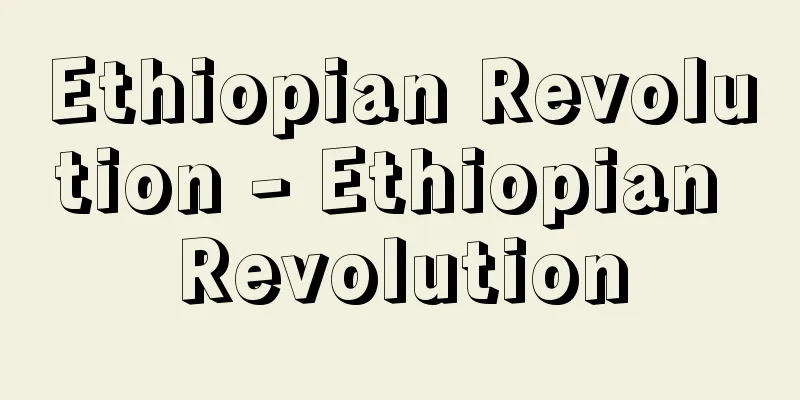Ethiopian Revolution - Ethiopian Revolution

|
The Ethiopian Revolution refers to the revolution led by the left wing of the military that overthrew the semi-feudal and authoritarian ruling system of Haile Selassie I (1892-1975) on September 12, 1974, and subsequently developed into socialist reforms in politics, the economy, and society. Ethiopia, the oldest independent country in Africa, underwent a territorial unification movement in the late 19th century under Theodore II. In the fourth quarter of the same century, the northern ruling class and warrior class began seizing land, and the unique semi-feudal land system that had previously only existed in the north gradually spread and took root in the south. The country's privileged class, consisting of the imperial family at the top, aristocrats, senior priests, etc., relied on this semi-feudal land system. Ethiopia's political system also remained outdated. Haile Selassie I established the country's first constitution in 1931 and transitioned the country to a constitutional monarchy, but in reality the emperor held absolute power over the legislative, judicial and administrative affairs, and although there was a bicameral parliament, political parties were not permitted to exist, meaning that the system had virtually no means of reflecting public opinion in politics. Even after the end of World War II and the dawn of an age of independence and change in Africa, Ethiopia's pre-modern ruling system showed no signs of change. The Guard's coup d'état in December 1960 ended in failure, but it was enough to foresee that the emperor's ruling system would not last much longer. In early 1974, amid a food crisis caused by the drought that had been occurring for several years, and runaway inflation accelerated by the oil crisis of the autumn of 1973, a rebellion broke out in the military demanding better working conditions, and anti-regime demonstrations and strikes broke out one after another in the capital, Addis Ababa, by teachers, students, and workers. The emperor, finding it impossible to suppress these movements by force, tried to deflect the criticism by announcing measures to improve the working conditions of soldiers and to establish a new constitution for democratization within six months, but to no avail. The anti-regime movement spread to rural areas in March, and there were frequent incidents of landlords and government officials being expelled by the people. Meanwhile, a revolutionary committee called the Military Coordination Committee (Derg) was created within the military in April, and the anti-regime movement gradually developed into a revolution. The Derg carried out a struggle for power and purging of the privileged classes, and finally dethroned the emperor on September 12th, establishing a military government (Provisional Military Administrative Council), and in December issued a socialist declaration, clarifying its policy of transformation into a socialist republic. However, influenced by the Eritrean conflict, the Ogaden conflict, and armed struggle by anti-government forces, the construction of socialism did not progress easily, and the planned return to civilian rule was finally realized after 10 years of military rule with the formation of a single political party, the Workers' Party of Ethiopia (WPE), in September 1984. The revolution continued under the leadership of Lt. Col. Mengistu Haile Mariam (later the first president), who purged Chairman Teferi Benti in February 1977 and became his successor as Chairman of the Derg. However, amidst continuing military offensives by the Eritrean People's Liberation Front (EPLF) and the Tigray People's Liberation Front (TPLF), the revolution was virtually thwarted in 1990 after the end of the Cold War, when the Marxist path was abandoned without any results in building socialism. In May 1991, the capital was surrounded by the Ethiopian People's Revolutionary Democratic Front (EPRDF), the main force of which was the TPLF, and Mengistu fled into exile in Zimbabwe. In the same year, EPRDF Secretary-General Meles Zenawi became President. Ethiopia began on the path to democratization and economic reconstruction, but the political situation has remained unstable ever since. [Hideo Oda] Source: Shogakukan Encyclopedia Nipponica About Encyclopedia Nipponica Information | Legend |
|
1974年9月12日にハイレ・セラシエ1世(1892―1975)の半封建的・権威主義的支配体制を打倒し、以後、政治・経済・社会の社会主義的改革へと発展していった、軍部左派主導の革命をいう。アフリカ最古の独立国エチオピアでは、テオドロス2世による19世紀後半の領土統一運動を経て、同世紀第4四半期には北部支配層・武士階級による土地の収奪が進行し、それまで北部にしか存在しなかった独特の半封建的な土地制度が、南部にもしだいに拡大し定着した。皇室を頂点とし、貴族・上級僧侶(そうりょ)などから構成される同国の特権階級は、この半封建的土地制度に依存していた。エチオピアの政治制度もまた旧弊なままであって、ハイレ・セラシエ1世は1931年に初の憲法を制定し、同国を立憲君主制に移行させたが、その実、皇帝は立法、司法、行政上の絶対権を握り、二院制の議会はあっても政党は存在を認められず、民意を政治に反映する手段は、制度上ないも同然であった。第二次世界大戦が終わり、やがてアフリカに独立の時代、変革の時代が訪れても、エチオピアの前近代的支配体制は変わる兆しをみせなかった。1960年12月に起こった親衛隊のクーデターは、結局は失敗に終わったが、皇帝の支配体制がもはや長くは続かないことを予感させるに十分なできごとであった。 1974年初め、数年前からの干魃(かんばつ)による食糧危機と、1973年秋の石油危機によって加速された悪性インフレが続くなかで、待遇改善を要求する軍隊の反乱が起こり、さらに首都アディス・アベバにおける教員、学生、労働者などの反体制デモやストライキが続発した。これらの動きを力で抑えられないとみた皇帝は、兵士の待遇改善のほか、民主化のための新憲法を6か月以内に制定する措置を発表するなどして、矛先をかわそうとしたが、むだであった。反体制運動は3月には農村部に波及し、地主や役人が民衆によって追放される事件も頻発した。他方4月には軍部内に軍事調整委員会(デルグ)とよばれる革命委員会がつくられ、反体制運動を革命へとしだいに発展させていった。デルグは特権階級に対する奪権闘争や粛清を進め、9月12日にはついに皇帝を廃位して、軍部政権(臨時軍事行政評議会)を樹立し、12月には社会主義宣言を発して、社会主義共和国への変革の方針を明らかにした。しかし、エリトリア紛争、オガデン紛争、反政府勢力の武力闘争などの影響もあって、社会主義建設は容易に進まず、予定された民政復帰も、1984年9月、単一政党エチオピア労働党(WPE)の結成で、軍政10年にしてようやく実現した。その後も、1977年2月にテフェリ・ベンティ議長を粛清して後任のデルグ議長に就任したメンギスツ・ハイレ・マリアム中佐(のち初代大統領)のもとで革命の推進が図られたが、エリトリア人民解放戦線(EPLF)、ティグレ人民解放戦線(TPLF)などの軍事攻勢が続くなかで、社会主義建設の成果をあげえないまま、冷戦終結後の1990年にマルクス主義路線を放棄し、革命は事実上挫折(ざせつ)した。その後1991年5月にTPLFを主力とするエチオピア人民革命民主戦線(EPRDF)に首都を包囲され、メンギスツはジンバブエに亡命した。同年、EPRDF書記長メレス・ゼナウィが大統領に就任。エチオピアは民主化と経済再建の道を歩みはじめたが、その後も政情は不安定である。 [小田英郎] 出典 小学館 日本大百科全書(ニッポニカ)日本大百科全書(ニッポニカ)について 情報 | 凡例 |
>>: Ethiopian Music - Ethiopian Music
Recommend
Passing Komachi - Passing Komachi
Noh piece. The fourth piece. A current piece of t...
United Kingdom of Great Britain
A kingdom formed in 1707 by the union of England a...
August Schmarsow
1853‐1936 A German art historian and one of the pi...
Ethiopian Music - Ethiopian Music
The liturgical music of the Coptic Church, a sect ...
Red colobus
A species of primate in the Cercopithecidae family...
《Elegance》 -
...the oldest works include the English Beowulf, ...
AT Feeding System - AT Feeding System
...On the other hand, with AC, the voltage can be...
Law Concerning the Regulation of Nuclear Source Materials, Nuclear Fuel Materials and Nuclear Reactors
…Official name: Law Concerning the Regulation of ...
Mani Kongo (English spelling)
…Then in 1482, the Portuguese Diogo Cão led a fle...
Hirato Renkichi
Year of death: July 20, 1922 Year of birth: Decemb...
Kafkaztool - Kafkaztool
...A wild goat very similar to the ibex. It inhab...
Lampadius, WA (English spelling) LampadiusWA
…The Swedish Torbern Olof Bergman (1735-84) was t...
Tāsā (English spelling)
… [Primitive agricultural culture] In the Alluvia...
Red dumplings - Akadango
〘Noun〙 (From the fact that mugwort used to make du...
garden pink
...It is a cushion-like perennial plant with a sl...









![JC Penney [company] - JCPenney](/upload/images/67cbb91d4b749.webp)